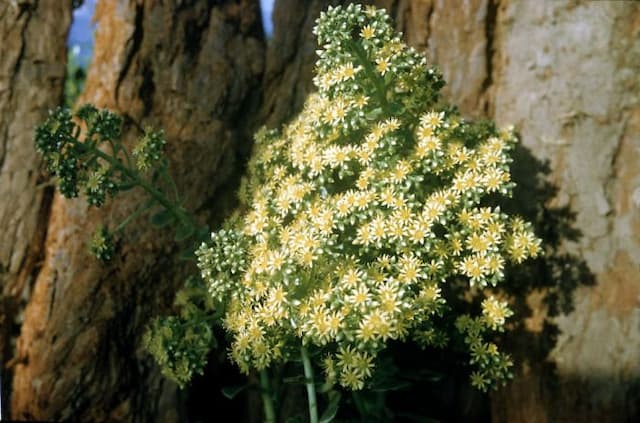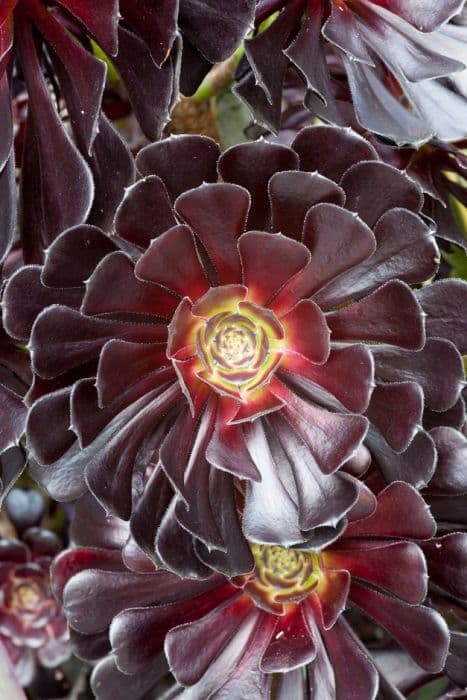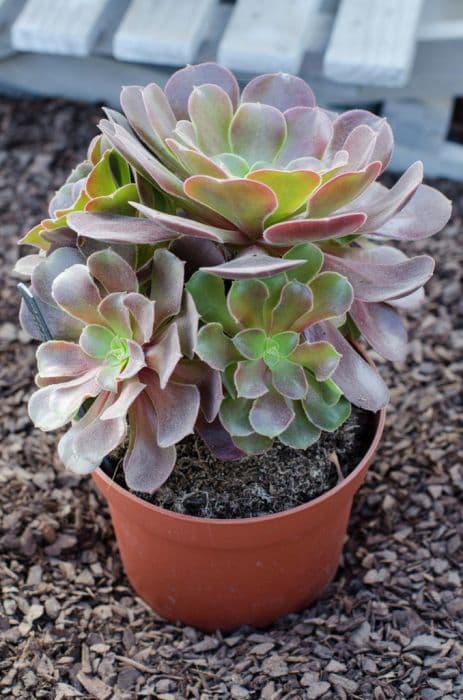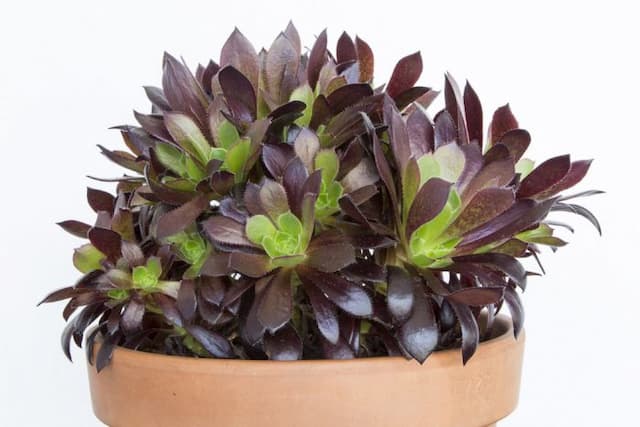October Daphne Hylotelephium sieboldii 'Misebaya-nakafu' (v)

ABOUT
The plant known as October Daphne boasts rounded, fleshy leaves that create a unique, mat-forming spread. These leaves have a distinctive coloration: they are green with a creamy white border, giving them a variegated appearance. In fall, the October Daphne flourishes with bright pink flowers that contrast beautifully with its variegated foliage. These flowers are star-shaped and come together in clusters, adding a splash of color to the autumn landscape. The combination of variegated foliage and vibrant pink blooms makes this plant an eye-catching addition to any garden setting.
About this plant
 Names
NamesFamily
Crassulaceae.
Synonyms
October Daphne, Siebold's Stonecrop, Siebold’s Sedum.
Common names
Sedum sieboldii 'Mediovariegatum', Hylotelephium sieboldii 'Mediovariegatum'.
 Toxicity
ToxicityTo humans
October Daphne, the most common common name for Hylotelephium sieboldii 'Misebaya-nakafu' (v), is not widely known for its toxicity to humans. However, as a general rule, consumption of any non-edible plant can lead to gastrointestinal discomfort, nausea, vomiting, or diarrhea. If you suspect poisoning from any part of this plant or if symptoms occur, it's advisable to seek medical advice.
To pets
October Daphne, also known as Hylotelephium sieboldii 'Misebaya-nakafu' (v), is similarly not renowned for being toxic to pets. Nevertheless, pets digesting non-food plants can experience mild to moderate gastrointestinal upset, which may include symptoms like vomiting or diarrhea. If a pet shows signs of distress after ingesting any part of this plant, contacting a veterinarian is recommended.
 Characteristics
CharacteristicsLife cycle
Perennials
Foliage type
Deciduous
Color of leaves
Variegated
Flower color
Pink
Height
1 foot [30 cm]
Spread
1 foot [30 cm]
Plant type
Succulent
Hardiness zones
3
Native area
Asia
Benefits
 General Benefits
General Benefits- Aesthetic appeal: Hylotelephium sieboldii 'Misebaya-nakafu', also known as October Daphne, has attractive round, blue-green leaves with creamy-white variegation and pink edges, which add a unique visual interest to gardens.
- Low maintenance: This succulent plant is easy to care for and requires minimal watering, making it suitable for gardeners of all skill levels.
- Drought resistance: Once established, October Daphne has excellent drought tolerance, which makes it ideal for xeriscaping and water-wise gardens.
- Cold hardiness: The plant can tolerate cold temperatures and is suitable for growing in USDA hardiness zones 3 to 9, making it versatile for different climates.
- Late season blooming: It produces pink, star-shaped flowers in the fall when many other plants have finished blooming, providing color and interest in the garden during this time.
- Attracts pollinators: The flowers attract bees, butterflies, and other beneficial insects, contributing to the biodiversity and health of the garden ecosystem.
- Soil adaptability: October Daphne can thrive in a variety of soil types as long as the soil is well-draining, which makes it accommodating to different landscape conditions.
- Compact growth habit: With its compact size and spreading habit, it is suitable for ground cover, rock gardens, and container gardening, providing versatility in garden design and space utilization.
 Medical Properties
Medical PropertiesThis plant is not used for medical purposes.
 Air-purifying Qualities
Air-purifying QualitiesThis plant is not specifically known for air purifying qualities.
 Other Uses
Other Uses- Aesthetic purposes in fairy gardens: Due to its compact size and attractive foliage, October Daphne makes a charming addition to miniature fairy garden landscapes.
- Groundcover in rock gardens: The plant's spreading habit and succulent leaves can fill in spaces between rocks, adding greenery and color.
- Education in plant propagation: October Daphne is easily propagated from cuttings or leaves, making it a good specimen for educational projects on vegetative propagation techniques.
- Soil erosion control: When planted on slopes or in areas prone to erosion, the roots of October Daphne help hold soil in place.
- Photography subject: The distinct appearance of October Daphne, especially when it blooms, makes it a popular subject for plant photography and botanical illustration.
- Companion planting: In mixed containers or beds, October Daphne can be planted alongside other succulents or alpine plants that have similar growing requirements.
- Art inspiration: The intricate form and coloring of October Daphne can serve as inspiration for artists and crafters in various mediums.
- Seasonal decoration: Its pink blooms and attractive fall foliage make October Daphne suitable for autumn-themed arrangements and decorations.
- Floral arrangements: Though not a traditional cut flower, the stems of October Daphne can be used in dried floral arrangements.
- Culinary decoration: Edible flowers from October Daphne can adorn cakes and pastries, though they should be used sparingly and with caution due to potential toxicity if consumed in large amounts.
Interesting Facts
 Feng Shui
Feng ShuiThe October Daphne is not used in Feng Shui practice.
 Zodiac Sign Compitability
Zodiac Sign CompitabilityThe October Daphne is not used in astrology practice.
 Plant Symbolism
Plant Symbolism- Perseverance and Resilience: Also known as October Daphne, Hylotelephium sieboldii 'Misebaya-nakafu' is a succulent that can withstand drought and harsh conditions, symbolizing the ability to endure and thrive through challenges.
- Harmony with Nature: October Daphne often blends seamlessly into its natural surroundings, signifying a connection with the environment and the balance of living in harmony with the Earth.
- Beauty and Longevity: With its attractive foliage and pink star-shaped flowers, October Daphne is often associated with timeless beauty and a long life, much like the plant's own longevity and perennial growth habit.
 Water
WaterOctober Daphne should be watered regularly but allowed to dry out slightly between waterings. During peak growing season, in spring and summer, water approximately once a week, using about 1 gallon per plant, depending on the size and the environmental conditions. Cut back on watering in the fall and water sparingly in winter, perhaps once a month or less, depending on the humidity and temperature, as the plant is drought-tolerant and prefers drier soil during its dormant period.
 Light
LightOctober Daphne thrives best in full sun to partial shade conditions. It is ideal to place it in a spot where it receives at least 6 hours of sunlight each day. However, in extremely hot climates, providing afternoon shade will help prevent scorching of the leaves.
 Temperature
TemperatureOctober Daphne prefers a temperate climate with the ideal growing temperature ranging between 60°F to 75°F. It can survive brief periods of colder temperatures down to 30°F but is not frost-hardy. During the winter, it is important to protect the plant from temperatures below freezing.
 Pruning
PruningOctober Daphne should be pruned to maintain its shape and to encourage thicker growth. The best time to prune is after flowering, typically in late fall or early winter. Pruning can be done annually or biennially, removing any damaged or overgrown stems to preserve the plant's appearance and health.
 Cleaning
CleaningAs needed
 Soil
SoilOctober Daphne (the common name of Hylotelephium sieboldii 'Misebaya-nakafu') thrives in well-draining soil with a mixture of potting soil, coarse sand, and perlite or pumice. Aim for a soil pH between 6.0 and 7.0 to encourage healthy growth and flowering.
 Repotting
RepottingOctober Daphne should be repotted every 2 to 3 years or when it outgrows its pot, which promotes root health and refreshes the nutrient content of the soil.
 Humidity & Misting
Humidity & MistingOctober Daphne prefers a dry to average humidity level, as it is similar to its natural, drought-prone habitats, and can tolerate low humidity environments common in household settings.
 Suitable locations
Suitable locationsIndoor
Place in bright, indirect light and avoid overwatering.
Outdoor
Needs full sun to partial shade and well-drained soil.
Hardiness zone
4-9 USDA
 Life cycle
Life cycleOctober Daphne (Hylotelephium sieboldii 'Misebaya-nakafu') begins its life as a seed which, when sown in well-drained soil and with adequate warmth, will germinate to produce tiny, succulent seedlings. As the seedlings grow, they develop fleshy, rounded leaves in a whorled arrangement and a compact, spreading habit, indicative of young plants in the vegetative stage. Once mature, the plant enters the flowering stage, typically in the fall, producing clusters of star-shaped, pink blooms that attract pollinators. After pollination, the flowers will develop into seed capsules, containing seeds that can be dispersed to create new plants. During winter, the plant may die back, especially in colder climates, entering a dormant phase until warmth returns in the spring and the growth cycle resumes. Over years, the plant can slowly grow larger and may need division to maintain health and manage its size.
 Propogation
PropogationPropogation time
Early spring
Hylotelephium sieboldii 'Misebaya-nakafu', commonly known as October Daphne, is best propagated through leaf cuttings, which is the most popular method for this succulent. Leaf cuttings should be taken during the warmer months, preferably in the spring or early summer, for the best chances of root development. To propagate, select a healthy leaf and gently twist it from the stem, ensuring that the base of the leaf is intact. Let the cutting dry for a day or two until the cut end callouses over to prevent rotting. Then, place the leaf on top of a well-draining soil mix, without burying it, in a spot with bright, indirect light. Within a few weeks, new roots will form, and eventually, a new rosette will begin to grow at the base of the cutting. Keep the soil slightly moist but be careful not to overwater, as this could cause the leaf to rot before it takes root.









